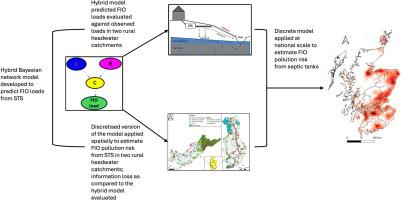Validating a Bayesian network model to characterise faecal indicator organism loss from septic tank systems in rural catchments
IF 12.4
1区 环境科学与生态学
Q1 ENGINEERING, ENVIRONMENTAL
引用次数: 0
Abstract
Validating model predictions with observed data is crucial for fostering confidence in model results, yet it is often overlooked in Bayesian Network (BN) studies. This research validated a BN model designed to predict faecal indicator organism (FIO) loss from septic tank systems (STS) in rural catchments (Cessnock and Mein). Both a hybrid model (combining continuous and discrete variables) and a fully discretised model were assessed. Our approach to model validation employed four methods: (1) comparing probability distributions of simulated and observed FIO loads in the hybrid model, (2) sensitivity analysis in the discrete model to identify key variables influencing results, (3) estimating percentage bias to evaluate the average difference between predicted and observed FIO loads in the hybrid model, and (4) applying Shannon entropy to measure uncertainty in the discrete model’s spatial application. Predicted FIO loads per STS were consistent across models, with the hybrid network estimating 4.63 × 10¹⁰ cfu/yr in the Cessnock catchment and 4.36 × 10¹⁰ cfu/yr in the Mein catchment, while the discrete network predicted 3.85 × 10¹⁰ cfu/yr and 3.65 × 10¹⁰ cfu/yr, respectively, closely aligning with observed values of 6.17 × 10¹⁰ cfu/yr and 5.10 × 10¹⁰ cfu/yr. Sensitivity analysis identified STS condition and treatment level as critical factors influencing FIO loss. Shannon entropy values (1.60–1.85) revealed significant uncertainty in model predictions in the catchment where STS were associated with a variability of Hydrology of Soil Types (HOST)-derived risk factors. When applied at national scale, greater confidence in model results was associated with Central, East and West Scotland where most STS were associated with a moderate to high HOST-derived risk classification. Our research is the first to show how BN models can predict FIO pollution from STS to watercourses and the findings suggest that refining model predictions requires more accurate data on STS treatment levels and maintenance, as well as access to good quality high-resolution stream water quality monitoring data.

验证贝叶斯网络模型,以表征农村集水区化粪池系统中粪便指示生物的损失
用观测数据验证模型预测对于提高模型结果的可信度至关重要,但这在贝叶斯网络(BN)研究中经常被忽视。该研究验证了BN模型,该模型旨在预测农村集水区化粪池系统(STS)的粪便指示生物(FIO)损失(Cessnock和Mein)。对混合模型(结合连续变量和离散变量)和完全离散模型进行了评估。我们的模型验证方法采用了四种方法:(1)比较混合模型中模拟和实际FIO负荷的概率分布;(2)在离散模型中进行敏感性分析,以确定影响结果的关键变量;(3)估计百分比偏差,以评估混合模型中预测和实际FIO负荷之间的平均差异;(4)应用香农熵来衡量离散模型空间应用中的不确定性。预测FIO加载/ STS跨模型是一致的,与混合网络估计4.63 ×10 ¹⁰cfu /赛斯诺克棚的流域的年和4.36 ×10 ¹⁰cfu /年我的排水,而离散网络预测3.85 ×10 ¹ ⁰cfu /年和3.65×10 ¹⁰cfu /年,分别调整密切观测值为6.17 ×10 ¹ ⁰cfu /年和5.10×10 ¹⁰cfu /年。敏感性分析发现STS状况和治疗水平是影响FIO损失的关键因素。Shannon熵值(1.60-1.85)表明,在集水区,STS与土壤类型水文(HOST)衍生的风险因素的变异性相关,其模型预测存在显著的不确定性。当在全国范围内应用时,对模型结果的更大信心与苏格兰中部,东部和西部有关,其中大多数STS与中度至高度的宿主衍生风险分类相关。我们的研究首次展示了BN模型如何预测从STS到水道的FIO污染,研究结果表明,改进模型预测需要更准确的STS处理水平和维护数据,以及获得高质量的高分辨率溪流水质监测数据。
本文章由计算机程序翻译,如有差异,请以英文原文为准。
求助全文
约1分钟内获得全文
求助全文
来源期刊

Water Research
环境科学-工程:环境
CiteScore
20.80
自引率
9.40%
发文量
1307
审稿时长
38 days
期刊介绍:
Water Research, along with its open access companion journal Water Research X, serves as a platform for publishing original research papers covering various aspects of the science and technology related to the anthropogenic water cycle, water quality, and its management worldwide. The audience targeted by the journal comprises biologists, chemical engineers, chemists, civil engineers, environmental engineers, limnologists, and microbiologists. The scope of the journal include:
•Treatment processes for water and wastewaters (municipal, agricultural, industrial, and on-site treatment), including resource recovery and residuals management;
•Urban hydrology including sewer systems, stormwater management, and green infrastructure;
•Drinking water treatment and distribution;
•Potable and non-potable water reuse;
•Sanitation, public health, and risk assessment;
•Anaerobic digestion, solid and hazardous waste management, including source characterization and the effects and control of leachates and gaseous emissions;
•Contaminants (chemical, microbial, anthropogenic particles such as nanoparticles or microplastics) and related water quality sensing, monitoring, fate, and assessment;
•Anthropogenic impacts on inland, tidal, coastal and urban waters, focusing on surface and ground waters, and point and non-point sources of pollution;
•Environmental restoration, linked to surface water, groundwater and groundwater remediation;
•Analysis of the interfaces between sediments and water, and between water and atmosphere, focusing specifically on anthropogenic impacts;
•Mathematical modelling, systems analysis, machine learning, and beneficial use of big data related to the anthropogenic water cycle;
•Socio-economic, policy, and regulations studies.
 求助内容:
求助内容: 应助结果提醒方式:
应助结果提醒方式:


